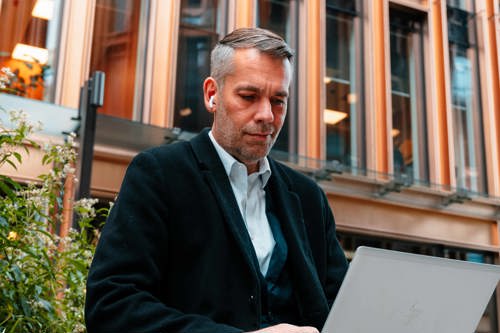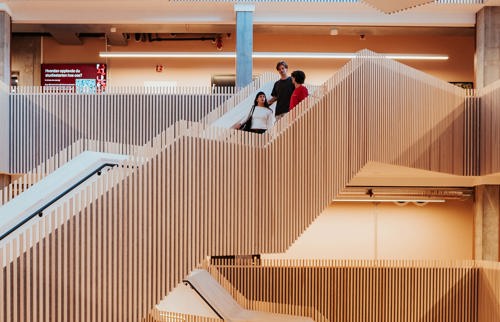AI is a major component of Kristiania's IT studies
The Smart Security Lab at the School of Economics, Innovation, and Technology (SEIT) at Kristiania is a state-of-the-art research environment for cyber security and smart technology. Here, artificial intelligence (AI) plays a crucial role in combating cyber crime.
Associate Professor Andrii Shalaginov greets us with a big smile. He teaches cyber security, researches smart security, and speaks enthusiastically about the projects and equipment in the Smart Security Lab.
Fortifying cyber security with AI
– AI, or Artificial Intelligence, is incredibly relevant right now. Everyone using smart technology relies on AI in their daily lives. Here, we teach students how to use AI to identify attacks on smart devices, Andrii explains passionately.
Together with fellow researchers at Kristiania, Andrii Shalaginov has developed a unique AI-based solution capable of detecting viruses and cyber attacks on smart devices. This AI model is part of research projects ENViSEC and SecureUAV, with one clear objective: strengthening cyber security.
– The advantage of using AI for this is that even if a virus evolves slightly, our AI model can still detect it, Andrii says.
Small smart devices and massive computers
Smart devices like smartwatches, smartphones, cameras, voice assistants, and temperature sensors are small and typically have limited local storage.
– Because storage is limited, you can’t train an AI model directly on the device. That’s why we develop the AI model in the cloud and install it on the device, Andrii explains.
– A smart device can recognise a cyber attack with a tiny 5kB AI model. That’s the smart part of IoT, the researcher says with a smile.
But training the AI model to protect these small devices against cyber attacks requires massive computers—something the Smart Security Lab and SEIT have.
A portable 192 TB cloud
– This is high-performance computing, Shalaginov says, pointing to a glass door.
To the untrained eye, it might look like an ordinary gray server room, but for the researcher, it makes every day exciting.
– Calculations that take a week on a normal laptop only take minutes here. It has 192 TB of storage, roughly equivalent to a hundred regular laptops. It can perform massive computations quickly and acts as a portable cloud.
– Here, we analyse large datasets using smart data analytics. And when I say large, I mean vast amounts of data.
– We use the data to train our AI model so that it can recognise viruses. Then we conduct experiments and simulations. For example, we’ll simulate data being under attack or infected with viruses, Shalaginov says.
Practical experience with digital forensics
– The purpose of all the equipment is to generate data, test new attacking scenarios, and explore how we can efficiently use AI to identify and prevent cyber attacks. Students are exposed to these methods because we know the industry demands hands-on expertise in exactly these areas.
– We have instruments and equipment here that no other students in Norway get their hands on. At Kristiania, we focus on the consumer perspective, ensuring our students are well-prepared for the industries they’ll work in, by giving the students practical experience, not just theoretical knowledge, Shalaginov emphasises.
Close ties to the industries
Shalaginov is dedicated to inviting guest lecturers with extensive experience in cyber security, both nationally and internationally. He believes students must understand the industry perspective. This includes learning about the problems they are expected to solve, how to apply for jobs, and preparing them for working life.
– Kristiania stands out because we maintain very close ties with the industries. Our programmes follow industry standards and practices, such as ISO/NIST standards and CCSK/CEH certifications for cyber security. We teach students how to apply these, giving them practical experience and theoretical knowledge.
Learning to translate theory into practice
– A clear challenge in cyber security is that some areas are highly theoretical, like cryptography or theoretical concepts for intrusion detection. If students lack practical experience, they may spend the first six months of their careers figuring out how to translate theory into practice. We address this in the Smart Security Lab and by involving an exceptional team of lecturers. We also invite guest lecturers with 10–20 years of industry experience to explain how things are done in the field.
– Kristiania also has a strategic geographical advantage, as most cyber security jobs in Norway are located here in Oslo. Large companies, for example, in Lysaker and Fornebu, need consultants with the right expertise. Studying here, where the jobs are, is a significant advantage, he concludes.
Master Cyber Security + Technology studies

Master in Cyber Security
Build the next generation of digital defence with a Master in Cyber SecurityMaster in Cyber Security
Tech studies at Kristiania
Choose between nine technology-related master's degreesTech studies at Kristiania




